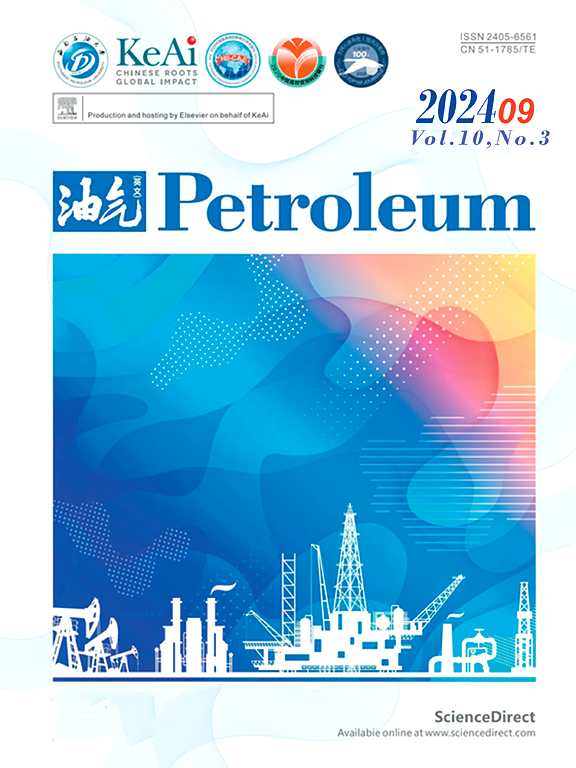结合增稠剂对高矿化度返排液和采出水的未处理回用制备压裂液
IF 4.2
Q2 ENERGY & FUELS
引用次数: 0
摘要
利用返排液和采出水配制压裂液是目前急需解决且尚未解决的问题。本文采用自由基共聚法制备了一种抗盐缔合增稠剂(AAT),并用FTIR和1H-NMR对其分子结构进行了表征。通过与普通抗盐稠化剂(HAT)的对比,系统考察了AAT在苏里格气田淡水、返排液和采出水条件下的综合性能。结果表明:在平均盐度为34,428 mg/L、平均高价离子含量为4967 mg/L的条件下,AAT具有良好的增稠能力、抗温抗剪能力、减阻能力、携砂能力、破胶性能以及与有机锆交联剂在高盐度下的高效交联能力;说明利用高矿化度返排液和采出水制备压裂液无需进一步处理具有很大的潜力和可行性。此外,缔合增稠剂实现高效减阻和携砂的可能机制可能是可逆超分子结构的存在和湍流状态下剪切拉伸粘弹性的显著增加。同时,物理和化学相互作用对缔合增稠剂的高效交联能力有重要贡献。研究结果可为新型压裂液的设计和高矿化度水在增产作业中的再利用提供重要参考。本文章由计算机程序翻译,如有差异,请以英文原文为准。
Untreatment reutilization of high-salinity flowback fluid and produced water to prepare fracturing fluid by using associative thickener
Reutilizing flowback fluid and produced water to prepare fracturing fluid is still an urgent problem that needs to be solved and is not well solved. In this work, an anti-salt associative thickener (AAT) was synthesized by free radical copolymerization, and the molecular structure of AAT was demonstrated by FTIR and 1H-NMR. Furthermore, compared with a common anti-salt thickener (HAT), the comprehensive performances of AAT were systematically investigated under the conditions of fresh water, flowback fluid and produced water in Sulige Gasfield. The results show that under the conditions of an average salinity of 34,428 mg/L and an average high-valent ion content of 4967 mg/L, AAT can present good thickening capacity, temperature and shear resistance, drag reduction efficiency, sand-carrying ability, gel-breaking property and high-effective crosslinking capacity with organic zirconium crosslinker at high salinity, which implicates the great potential and feasibility to prepare fracturing fluid by reutilizing high-salinity flowback fluid and produced water without further treatment. Moreover, the possible mechanisms of the associative thickener to achieve high-effective drag reduction and sand-carrying might be the existence of reversible supramolecular structures and the significant increase of viscoelasticity by shear stretching in turbulent state. At the same time, both physical and chemical interaction can make a significant contribution to high-effective crosslinking capacity of associative thickener. All results and findings can provide an important reference for the design of novel fracturing fluid and the reutilization of high-salinity water in stimulation applications.
求助全文
通过发布文献求助,成功后即可免费获取论文全文。
去求助
来源期刊

Petroleum
Earth and Planetary Sciences-Geology
CiteScore
9.20
自引率
0.00%
发文量
76
审稿时长
124 days
期刊介绍:
Examples of appropriate topical areas that will be considered include the following: 1.comprehensive research on oil and gas reservoir (reservoir geology): -geological basis of oil and gas reservoirs -reservoir geochemistry -reservoir formation mechanism -reservoir identification methods and techniques 2.kinetics of oil and gas basins and analyses of potential oil and gas resources: -fine description factors of hydrocarbon accumulation -mechanism analysis on recovery and dynamic accumulation process -relationship between accumulation factors and the accumulation process -analysis of oil and gas potential resource 3.theories and methods for complex reservoir geophysical prospecting: -geophysical basis of deep geologic structures and background of hydrocarbon occurrence -geophysical prediction of deep and complex reservoirs -physical test analyses and numerical simulations of reservoir rocks -anisotropic medium seismic imaging theory and new technology for multiwave seismic exploration -o theories and methods for reservoir fluid geophysical identification and prediction 4.theories, methods, technology, and design for complex reservoir development: -reservoir percolation theory and application technology -field development theories and methods -theory and technology for enhancing recovery efficiency 5.working liquid for oil and gas wells and reservoir protection technology: -working chemicals and mechanics for oil and gas wells -reservoir protection technology 6.new techniques and technologies for oil and gas drilling and production: -under-balanced drilling/gas drilling -special-track well drilling -cementing and completion of oil and gas wells -engineering safety applications for oil and gas wells -new technology of fracture acidizing
 求助内容:
求助内容: 应助结果提醒方式:
应助结果提醒方式:


